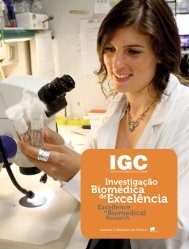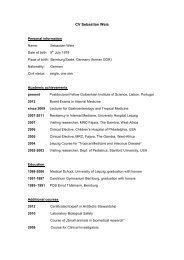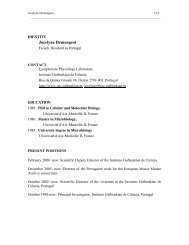organisation - the Instituto Gulbenkian de Ciência
organisation - the Instituto Gulbenkian de Ciência
organisation - the Instituto Gulbenkian de Ciência
- No tags were found...
Create successful ePaper yourself
Turn your PDF publications into a flip-book with our unique Google optimized e-Paper software.
hemocyte purification using a combination of GFP lines, specific staining and<br />
FACS analysis. Recently, we have shown that immune challenge leads to changes<br />
in total cell number and subset proportions. Moreover, using G-trace technique,<br />
we have <strong>de</strong>termined that such changes are not due to shifts in cell i<strong>de</strong>ntity but<br />
ra<strong>the</strong>r <strong>the</strong> result of differential proliferation and/or recruitment.<br />
We have now found new plasmatocyte subsets and shown that some of <strong>the</strong>se<br />
subsets change dynamically during larval <strong>de</strong>velopment. After confirming <strong>the</strong><br />
long standing hypo<strong>the</strong>sis that hemocytes are essential to resist parasitoid egg<br />
infections we have <strong>de</strong>scribed <strong>the</strong> plasmatocyte heterogeneity during this immune<br />
response. The results show that <strong>the</strong>re is a dynamic change in all plasmatocyte<br />
subsets during <strong>the</strong> immune response while <strong>the</strong>y maintain <strong>the</strong> expression of<br />
a differentiated plasmatocyte marker.<br />
EVOLUTION OF Drosophila melanogaster IMMUNE RESPONSE<br />
The mechanistic basis of <strong>the</strong> immune response in Drosophila has been wi<strong>de</strong>ly<br />
studied; however, little is known about <strong>the</strong> evolutionary and physiological<br />
mechanisms that drive local adaptation to pathogens. It is also unknown if this<br />
adaptation is <strong>de</strong>pen<strong>de</strong>nt on factors such as <strong>the</strong> infected life-stage, route of infection,<br />
pathogen type or multiple infections, and <strong>the</strong> associated tra<strong>de</strong>-offs. Using<br />
experimental evolution in Drosophila, to different and contrasting immune challenges,<br />
we have established <strong>the</strong> grounds to address <strong>the</strong>se questions and gain<br />
insights about <strong>the</strong> genes and mechanisms involved in adaption to pathogens.<br />
We have imposed 20 generations of experimental evolution in Drosophila un<strong>de</strong>r<br />
different immune challenges. These replicate populations have adapted to<br />
contrasting conditions and perform significantly better that controls. We are<br />
currently testing for <strong>the</strong> establishment of tra<strong>de</strong>-offs and will pursue <strong>the</strong> genetic<br />
basis of this adaptation.<br />
Cages containing Drosophila populations un<strong>de</strong>rgoing experimental evolution.<br />
Phylogenetic relationships between different dipterans used in <strong>the</strong> lab to study<br />
<strong>the</strong> origin and diversification of egg dorsal appendages (right panels).<br />
IGC ANNUAL REPORT ‘11<br />
RESEARCH GROUPS<br />
63






